Voltage control relays - purpose, selection and connection with your own hands

The best way to protect your home network from power surges is to install a properly sized voltage regulator. However, these devices are quite expensive, and if the voltage in the line is generally stable and the potential differences do not occur often, then the troubleshooting can be done using a voltage relay. It has a low cost, and if overvoltages in the line are rare, it copes well with the protective function. Moreover, if the neutral wire breaks or sagging cables are closed, the mains voltage relay will trip even faster than the stabilizer. In this material, we will talk about what a voltage control relay (RVC) is, understand its principle of operation and explain how to choose and connect a relay to the mains.
Content
Relay advantages over stabilizers
The use of a voltage relay for an apartment or for a house, if the stability of the line allows it, is in many ways preferable to installing stabilizers. Let's list the main advantages of ILV:
- Compactness. This device takes up much less space than any stabilizer.
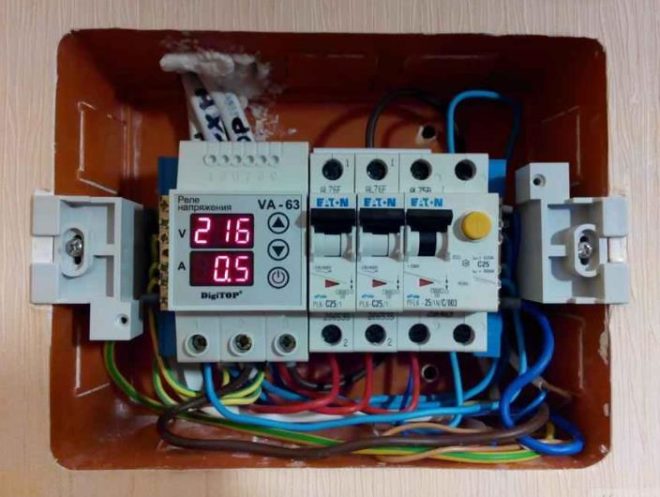
- Ease of installation. The voltage control element in the network can be installed inside the electrical panel on a DIN rail, and you don't even have to bother with connecting cables for a long time. And in order to install the stabilizer, you have to cut into the line (when installing the device indoors) or place the device inside a specially made protective box, next to the shield.
- Fast response. This is the main plus of the voltage monitoring relay. With a sudden jump in the potential difference, the element is triggered after only a few milliseconds. In this matter, only triac stabilizers can compete with the ILV, the price of which is an order of magnitude higher.
- Silence. The relays work quietly, while the working stabilizer can be heard even at a fairly large distance.
- Profitability. Compared to stabilizing devices, potential difference control elements consume a negligible amount of electricity.
- Low price. As already mentioned, voltage control relays are many times cheaper than stabilizers.
Given the above advantages of ILV, it becomes clear why, if possible, they should be chosen. And yet, having familiarized yourself with the advantages of these elements, it is not necessary to get carried away and put them everywhere instead of stabilizers.
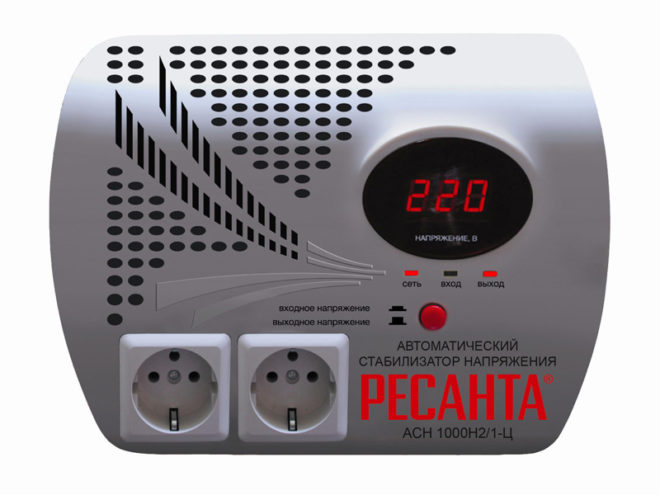
If you use a relay as a voltage cut-off for a refrigerator, and the potential difference in the network regularly jumps, then constant switching on and off the power will end in the fact that an expensive unit will fail after a few months.
How the control device works
The voltage monitoring relay works according to the following principle. The circuit of this device is designed so that electricity is constantly supplied to it from the network. The element measures the potential difference, and if the obtained value is within acceptable limits, then the keys built into the ILV remain open, and the flow of electrons freely flows to the consumers.
Visually about the relay in the video:
If there is a phase imbalance in the circuit or a powerful impulse caused by a lightning strike or switching occurs, the keys are instantly closed, the device is triggered, and the supply of electricity to the network stops. This prevents damage to the connected household appliances.The triggering process takes a few milliseconds.
After the parameters of the electron flow are normalized, the delay timer starts. It is provided by the circuitry of appliances such as air conditioners, refrigerators and freezers and must be followed for their correct operation.
Control devices adjust the delay time to maintain the desired period. When the programmed time has elapsed, the electricity supply will resume as usual.
Relay connection in single-phase networks
Let's figure out how to connect a single-phase relay in a home 220V network. The commutation takes place via a phase cable. The neutral wire must be connected to supply power to the internal circuit. The voltage relay connection diagram can be performed in one of two ways:
- Pass-through (direct) device connection.
- Joint connection of the device with the contactor performing the switching.
It is recommended to install and connect a single-phase RKN in front of the electric meter in order to ensure its protection in case of overvoltage, but after the automatic input. When there is already a seal on the meter, the control element is connected behind it. If a circuit breaker is installed immediately behind the sealed meter, the relay will have to be installed after it, separating the wire from the AB output and connecting it to the input of the potential difference control device.
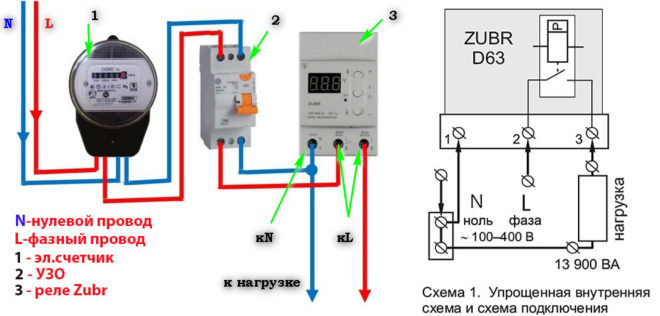
The RKN output is connected to the terminal to which the cable from the electric meter or VA was previously connected. The zero at the control element is connected from the zero bus using a separate conductor.
It should be remembered that protection against short-circuit and overcurrent is not the task of the voltage control relay, therefore it cannot replace the machine. These devices are connected to the line together, and the RKN rating must exceed the rated current of the circuit breaker by one value.
Clearly about the installation of a voltage relay in the video:
Joint installation of relay and contactor
An additional contactor is installed when the value of the switched currents is too high. Often, installing a relay together with a contactor is cheaper than buying an ILV, which will correspond to the parameters of the electron flow.
In this case, there is one requirement to the rated current of the control element - it must exceed the value at which the contactor operates. The latter will completely take over the current load.
This connection option has one, but rather significant, drawback - reduced performance. It is due to the fact that the time required for the reaction of the contactor is added to the milliseconds required for the control device to operate. Based on this, when choosing both devices, you need to pay attention to the highest possible speed of each of them.
When connecting this bundle, the phase wire from the VA is connected to a normally open contact.

This is the input of the contactor circuit. The RKN phase input must be connected via a separate cable. It can be connected to the input terminal of the contactor or to the output terminal BA.
Since the phase input of the control element is connected with a conductor of a smaller cross-section, attention must be paid to the reliability of the connection. To prevent it from falling out of the socket, which contains a thicker cable, both wires must be twisted together and fixed with solder or crimped with a special sleeve.
When installing, make sure that the conductor suitable for the relay is firmly attached. To connect the RKN output to the contactor solenoid terminal, use a cable with a diameter of 1 - 1.5 sq. Mm. The zero of the control element and the second terminal of the coil are connected to the zero bus.
The output of the contactor is connected to the distribution bus using a power phase conductor.
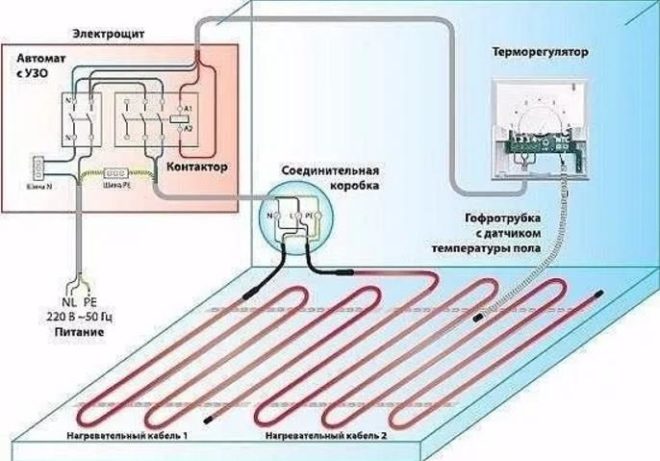
How is a voltage relay connected in three-phase networks?
Three-phase RKN, in the presence of overvoltage on at least one of the phases, disconnects the power supply to all three.From the input machine, three phases go to the input contact of the relay, the same number of phase conductors go to the output. The contactor solenoid is connected to any output of the control device.
The contactor to be connected must also have three phases to which the power phase cables are connected. When connecting three-phase equipment, care must be taken not to reverse the phases. It is not necessary to connect a separate ILV to each of them - by disconnecting one core, you can damage the equipment.
Connecting a voltage relay in a three-phase network in the video:
The nuances of choosing a device
When choosing a voltage relay, you must pay attention to the following parameters:
- Element performance.
- Possibility of regulation (setting the required delay time, as well as response limits).
- Rated current.
If the device has a digital indicator, it will be easier to set up, but in general, the presence of such a component is not essential. Before you go shopping or order a device online, it would be a good idea to visit specialized forums and read reviews.
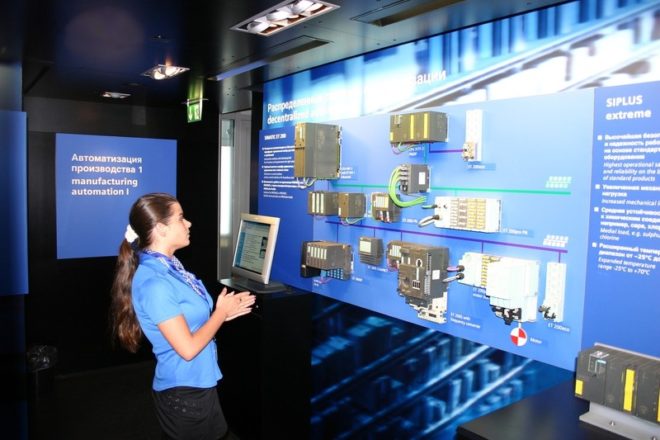
Pay attention to whether employees of manufacturing companies communicate with users. Openness indicates that the company has confidence in its products.
Conclusion
In this article, we talked in detail about what a voltage monitoring relay is, what are its advantages and disadvantages, and explained how to properly connect this device and what to look for when choosing. This information will be useful to our readers who are going to install a surge protection device in their home network.




